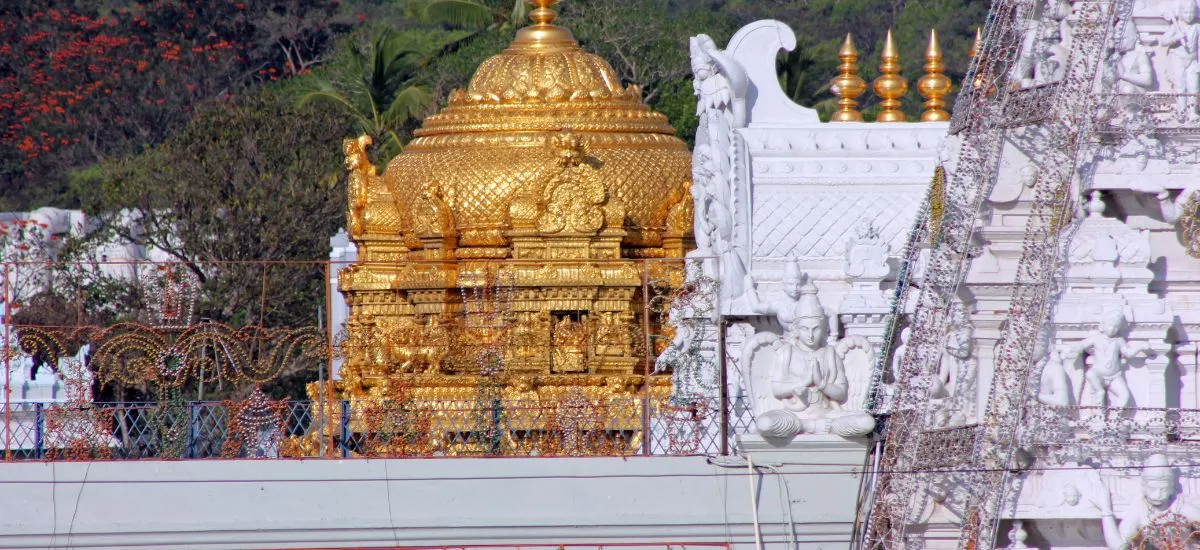
India as a whole is known as a diverse country that encompasses a variety of cultures, traditions, and festivals. But South India stands in precedence to preserve the culture, tradition, and the spectacular architectures that are 3000 years old.
Let us look into the 10 most popular temples that impeccably highlight the beauty and pride of South India.
Recommended Tour Packages
- Kerala Weekend Tour (3 Nights / 4 Days)
- Honeymoon Tour Package (4 Nights / 5 Days)
- Highlights of Kerala (4 Nights / 5 Days)
- Best of Kerala (6 Nights / 7 Days)
- Family Tour Package (6 Nights/ 7 Days)
1. Virupaksha Temple – Hampi, Karnataka.
Virupaksha, also known as the Pampapathi Temple at Hampi in the state of Karnataka, is one of the oldest and most significant ones. Having the main deity as Lord Shiva, who will be in the form of “Virupaksha”, a powerful state than the usual. Virupaksha means “an eye without a form”. The trinetra or the third eye was acquired when he burnt “Kama”- the lord of lust to ashes, who hid behind a tree and shot an arrow towards Shiva’s heart, making him fierce.
Art and Architecture:- The Temple follows the traditional Dravidian style of architecture, characterised by its pyramid-shaped towers or gopurams (towers) that are 165 feet tall. There’s a monolithic sculpture of Lord Narasimha, which stands at a height of about 6.7 meters (22 feet) and is considered one of the largest monolithic structures in Hampi.
Why should you visit Virupaksha temple?
Visiting this temple will give a different perspective towards life, like the different vision that the third eye of lord Shiva had. When it is referred to as the “third eye”, it symbolically means seeing something that the two sensory eyes cannot see. The third eye is to see your interiority – the internal nature of existence. The energy in this temple will give a conception through which one can perceive something beyond the physical nature and probe into self-introspection and realisation, understanding the purpose of life.
2. Sri Ranganathaswamy Temple – Tiruchirappalli, Tamil Nadu
Sri Ranganathaswamy Temple at Srirangam is dedicated to Lord Ranganatha, an avatar of Lord Vishnu. It is considered to be an important pilgrimage site for Vaishnavites, the followers of Lord Vishnu. According to legend, the temple was built by Lord Brahma, the creator of the universe. It is believed that Lord Ranganatha appeared in Lord Brahma’s dream and insisted that he create an idol of himself in a lying posture on a serpent named Adisesha.
Significance of art and architecture:- The most unique art form associated with the temple is the Tanjore painting. These are paintings characterised by the use of gold foil, eye-catching colours and intricate detailing. These paintings are often used to depict deities and represent scenes from the Hindu mythology.
Located at Srirangam island in the Tiruchirappalli district of Tamil Nadu, the Sri Ranganathaswamy Temple is well recognised for its architectural and artistic excellence. The temple has also been listed in the UNESCO World Heritage Site tentative list.
Why should you visit Ranganathaswamy Temple?
Visiting the Sri Ranganathaswamy Temple provides a chance for visitors to explore and appreciate the cultural heritage of Tamil Nadu. The premises of this temple are encapsulated with libraries, museums, and educational institutions that to date preserve ancient scriptures, artefacts, and historical records. It will not only be a spiritual visit but also give you a feeling of an educational visit when you come to the Sri Ranganathaswamy temple. You will have a chance to engage with the local community and participate in cultural activities so that you can have a deeper understanding of Tamil culture and traditions.
3. Meenakshi Amman Temple – Madurai, Tamil Nadu
The Pride of Madurai – Meenakshi Amman Temple, also known as Meenakshi Sundareswarar Temple, is dedicated to the goddess Meenakshi, an incarnation of Parvathi Devi, and her holy companion Lord Sundareswarar, an incarnation of Lord Shiva. The temple is one of the most well-known and significant religious sites in South India that attracts millions of devotees from all around the world.
According to legend, the temple was originally constructed by Indra, the king of the gods, when he found a lingam (an abstract form or representation of Lord Shiva) under a Kadamba tree. The Lingam was later enclosed in a shrine. As time passed by, the temple complex expanded and underwent numerous renovations and additions under different rulers and dynasties. But predominantly, the Pandya kings played a prominent role in the development of the temple.
They made significant contributions to its architecture and religious activities. People believe that Meenakshi Amman was once a queen of Madurai who got married to Lord Sundareshwar(Lord Shiva) in the Meenakshi Amman Temple. This holy place is also associated with 64 Thiruvilayadal puranas (A list of fun-filled miracles) performed by lord Shiva to teach people the moral ethics of life.
Significance of art and architecture – One of the major highlights of the temple is the Ayiram Kaal Mandapam (Thousand Pillar Hall), which is built out of a single rock. The most fascinating thing about this pillar is that, when you tap each pillar, it gives a different musical sound. Ariyanatha Mudaliyar has built a masterpiece that serves as an engineering excellence and a fantastic artwork.
Secondly, there is a holy pond called Porthamarai Kulam (Golden Lotus Tank), which is said to be the oldest part of the temple. According to legend, Lord Shiva appeared here as a man to marry Goddess Meenakshi. There is also another belief among people that lord Shiva burnt a poet called Nakeerar to ashes and brought him back to life in the same place. Devotees believe that taking a dip in this tank can cleanse them from their sins and bring them good fortune.
Why should you visit Meenakshi Amman Temple?
When you visit here, you are not only visiting the temple but also the pride of Madurai, which holds a lot of traditional and cultural significance. Visiting Madurai in the state of Tamil Nadu will give you the feeling of amusement and tranquillity simultaneously, as the place serves as a worship hub, a spot to look at exemplary artworks, and to be present in the place where a lot of unbelievable miracles happened.
If you are a lover of a massive celebration, then you must visit Madurai during the Chithirai Festival, A celebration that depicts the wedding ceremony of Goddess Meenakshi and Lord Shiva, attracting people from all over the world to cluster here in enormous numbers.
4. Sri Venkateswara Swami Temple – Tirupathi, Andhra Pradesh
The Tirumala Venkateswara Temple, well known as the Tirupati temple, is located in the hill town of Tirumala in the Tirupati district of Andhra Pradesh. Dedicated to Lord Venkateswara, an incarnation of Lord Vishnu, this beautiful temple is one of the prominent Hindu temples in South India. According to Hindu mythology, Lord Vishnu appeared on Earth in the form of Varaha Avatar (A form of a wild boar) to save the world from demons, and is said to have rested in the Tirumala, a tier of seven hills.
Significance of art and architecture:- The main deity of the temple, Lord Venkateswara, dwells in the sanctum sanctorum, which is embellished with gold-plated doors and a gold-covered gopuram – the structure over the garbhagriha. The golden gopuram shines brightly, emitting the divinity of the temple. The gold used in the gopuram is donated by devotees from all around the world as offerings to Lord Venkateswara, known as “Kaanika”.
One of the outstanding forms of painting in Tirupathi is Kalamkari – A traditional hand-painted art form. Another popular form of painting used here is the Tanjore paintings. The artist uses rich colours, gold leaf embellishments, and the use of precious stones like pearls and precious gems. Thus, the temple’s infrastructure is an example of a perfect blend of spirituality and aestheticism.
Why should you visit Sri Venkateshwara Temple?
The main deity, Lord Venkateshwara, is believed to be the richest god as devotees contribute gold, cash, jewellery, coins, and other forms of expensive things as a symbol of their devotion and gratitude. It would be a visual treat for the visitors to witness the beauty of the sculpture adorned with beautiful ornaments and decorations.
Apart from its religious significance, this place also showcases breathtaking natural beauty. The place offers picturesque views of lush green hills, cascading waterfalls, and attractive landscapes. En route to Tirupathi involves crossing through scenic routes, enabling an opportunity to connect with nature and enjoy a peaceful retreat, which will take you far from the hectic city life.
If you have a sweet tooth, you can never say no to one of the famous dishes in Tirupathi called “Laddu”. This unique Prasadham is distributed among devotees as a blessing. This dish is made from pure ghee, sugar, and flour, which will give a divine taste. It is a must-do experience for food enthusiasts to try this Prasadham.
Another spine-chilling fact that will make you visit this place is that you can see the Tirupathi hill, which exactly resembles the face of Lord Vishnu in a vertical position. This is a predominant reason that no one can compromise to visit this divine place.
5. Ramanathaswamy Temple – Rameswaram, Tamil Nadu
The Ramanathaswamy Temple, well known as the Rameshwaram Temple, at Rameswaram, is dedicated to Lord Shiva, who is worshipped in the form of Lingam. According to the Hindu epic Ramayana, Lord Rama (the seventh avatar of Lord Vishnu), along with his wife Sita and his loyal devotee Hanuman, visited this holy place after defeating the demonic king Ravana. Rama wanted to seek mercy for killing Ravana. Agastya, a sage in Hinduism, advised Lord Rama to install a lingam and perform a special puja (ritual) to redeem himself from the sin. The lingam, which is consecrated and worshipped by Lord Rama, is now worshipped by the devotees, and it is the main deity of the Ramanathaswamy Temple.
Significance of art and architecture:- The temple complex features several gopurams, one of the notable gopurams is the Kothandaramaswamy Gopuram, located on the eastern side of the temple. This gopuram showcases beautiful carvings depicting scenes from the Ramayana. The Kothandaramaswamy Gopuram also serves as an entrance to the famous Sethu Karai (Adam’s Bridge), believed to be built by Lord Rama himself with the help of monkey troops to cross the ocean and rescue Mother Sita, who was captivated by Ravana.
Why should you visit Ramanathaswamy Temple?
While visiting Rameswaram in the state of Tamil Nadu, you cannot limit yourself only to the temple, but explore nearby places like Dhanushkodi – An abandoned village that holds immense natural beauty. It is known for its pristine, crystal-clear beach and breathtaking sunsets.
Secondly, you can experience the engineering marvel of the Pamban Bridge that offers stunning views of the surrounding area. A walk on the bridge provides a unique experience as it spans across the glistening waters of the Palk Strait. You will be thrilled to see the Ram Setu Bridge built by Lord Rama. This gives captivating and picturesque visuals.
Make sure that you have never missed visiting Ariyaman Beach, which will make you enthralled with golden sands, clear blue waters, and a calm atmosphere. The beach also has facilities for water sports like jet skiing and banana boat rides. Finally, it can be concluded as a blissful journey, which gives you numerous experiences from a single trip.
6. Brahadeeswara temple- Thanjavur, Tamil Nadu
The Brahadeeswara Temple, well known as Thanjai Periya Kovil or Peruvudaiyar Kovil or Rajarajeswaram, is a Hindu temple dedicated to Lord Shiva. Located in the Thanjavur/Tanjore district of Tamil Nadu, the temple was built during the monarchy of the Chola dynasty under the supervision of King Raja Raja Chola 1 during the 11th century. It is considered to be one of the greatest architectural excellences of the Chola period.
Significance of art and architecture
The centrepiece of the temple has a massive lingam that is made of granite and stands at a height of about 3.7 meters, which is believed to be one of the largest lingams in India. Also, there is a statue of a huge Nandi (bull), which is carved out of a single stone that measures about 16 feet (5 meters) in height. One of the most extraordinary features of this temple is the unique construction technique. The temple is built in such a way that the shadow that comes from the main tower never falls on the ground at any time in the day.
Why should you visit the Brahadeeswara temple?
If you want to witness a true masterpiece, then this temple should be in your top notch. Visiting here provides a profound spiritual experience. Other than spiritual aspects, there are other features in the temple to witness, like paintings, sculptures and amazing architecture that even today’s technologies could not have thought of.
You will also have an opportunity to visit a library known as the Saraswathi Mahal Library – A house of a vast collection of ancient palm-leaf manuscripts and other historical documents. The library has stored valuable texts on numerous subjects such as literature, music, astrology, medicine, and philosophy. In addition, the temple complex contains numerous inscriptions that enable you to explore the history and cultural practices of the Chola dynasty.
7. Thanumalayan Temple – Kanyakumari, Tamil Nadu
The Thanumalayan Temple, also known as Sthanumalayan Kovil, located in the town of Suchindram in the Kanyakumari district of Tamil Nadu, is one of the few temples in India where three of the main deities are worshipped: the creator- Lord Vishnu, the protector – Lord Vishnu, and the destroyer – Lord Shiva.
Lord Shiva is worshipped in the form of Lingam, followed by lord Vishnu, represented by his respective symbol of the shankam (shell), and lord Brahman in the form of a lotus. It is believed by people that Lord Indra was cursed by Sage Gautama for his arrogance. To redeem himself from that, he installed a lingam at this location and performed penance. Fascinated by his devotion, Lord Shiva appeared before Indra and gave him a boon. Hence, the place came to be known as Suchindram, which means “purification by water.”
Significance of art and architecture:- While Kanyakumari is not a region in Kerala, it does share borders with the state, and the architecture of the temple is built in a way with a blend of Dravidian and Kerala style. The important art form that can be seen in this temple is the fresco paintings on the ceilings of the mandapas and corridors that depict divine scenes.
The innermost sanctum sanctorum is excellently built in a way that the devotees can simultaneously worship three gods under one roof. The temple complex also includes pillared halls and Musical Pillar, which are known for their exquisite stone carvings and which produce musical sounds when struck.
Why should you visit Suchindram Thanumalayan Temple?
This temple welcomes you with a serene and tranquil atmosphere and enables you to experience true spirituality and self-introspection. Visitors can engage in meditation, prayer, or simply soak in the spiritual vibes that are spread in the air.
Dance shows are an integral part of the temple’s cultural activities. The authorities of the temple organise these shows on special occasions or festivals to enhance the spiritual experience of the visitors. Starting from Bharatanatyam, other classical dance forms like Kathakali, Mohiniyattam, Kuchipudi, and Odissi are also showcased at Suchindram Temple. It would be an amazing experience to witness the graceful movements, facial expressions, and attractive costumes along with the mesmerising performances.
8. Murudeshwar Temple – Karnataka
Murudeshwar Temple is a famous Hindu temple located in the Uttara Kannada district of Karnataka. The main deity here is lord Shiva. This temple is known for its natural, breathtaking beauty as it is situated on the coast of the Arabian Sea.
According to Hindu mythology, Ravana, who carried a Linga to Srilanka, rested the Linga in a particular place and later found that the Linga was firmly rooted to the ground. Becoming angry, Ravana stuck the Linga with this sword, breaking it into several pieces. One of the pieces fell to Murudeshwar, where the temple stands today.
Significance of art and architecture:- The architecture of the Murudeshwar Temple is a blend of traditional Dravidian style and modern aesthetics. Shiva Linga, in this temple’s sanctum sanctorum, is made of pure granite and of a silver-plated railing. The temple complex also features a wonderful Raja Gopura (royal tower), which enables one to enjoy the panoramic views of the Arabian Sea. Another notable feature of the Murudeshwar Temple is the massive statue of Lord Shiva, which stands tall at a height of 123 feet (37 meters) and is considered to be the third-tallest statue of Lord Shiva in the world and the second-tallest statue of Lord Shiva in India.
Why should you visit Murudeshwar Temple?
This is an architectural marvel that will make you literally spellbound. Never miss the chance to see and immerse yourself in the beautiful Lord Shiva statue that stands majestically at a height of 123 feet. Another crowd-pleaser here is the skyscraping Temple Tower, which is 237 feet high, has 20 floors, and is considered the second-tallest Gopura (Temple Tower) in Asia. There is also a lift to take you to the top floor of the gopuram for a panoramic view of the landscape near the temple and the Arabian Sea. The small hill on which the temple is located will grasp your attention as you will see lush greenery around you. Simultaneously, you can also enjoy the view of the shimmering blue Arabian Sea that will make you submerge into serenity, making it a spectacular vision.
Apart from its religious and architectural significance, there is the scenic significance, offering breathtaking views of the surrounding natural beauty. Visiting here creates a tranquil ambience that is perfect for relaxation. Visitors can also enjoy recreational activities like swimming, beach walks, and water sports at the nearby Murudeshwar Beach.
9. The Kalaisathanar Temple – Kanchipuram, Tamil Nadu
The Kalaisathanar Temple at Kanchipuram is one of the must-visit temples in the state of Tamil Nadu. Built during the Pallava dynasty in the 7th century, it is one of the oldest temples in the region, dedicated to Lord Shiva. During the period of the Pallava dynasty, Kanchipuram served as a cardinal centre for art, culture, and religion, as they were great patrons of art, architecture, and temple construction. It is also believed that they played a crucial role in promoting Shaivism.
Significance of art and architecture:- One notable thing about the temple is that the temple’s tank, known as a “Pushkarini, is a sacred water used for ritualistic purposes. It is surrounded by a few smaller shrines and pavilions, adding to the overall beauty of the architecture.
Why should you visit Kailasanathar Temple?
If you wish to witness Lord Shiva in the form of Swaayambu Lingam (Self–Manifested), then this temple is a must-visit. Other than religious significance, the temple is surrounded by natural beauty. The temple is surrounded by lush green fields and scenic views of the landscape, providing a picturesque backdrop for the temple. Visitors can explore the surrounding areas, go on leisurely walks, and enjoy the tranquillity.
10. Sri Krishna Temple – Guruvayur, Kerala
Sri Krishna Temple or Guruvayurappan temple, located in Guruvayur, a town in the Thrissur district of Kerala, is a famous Krishna temple in South India. According to Hindu Mythology, after Krishna’s departure from Earth, his particular idol went missing for many years. Later, it was rediscovered by two of his devotees, who travelled to uproot the idol, in a perfect place, finally reaching Guruvayur.
Significance of art and architecture:- The Guruvayur Temple’s art reflects the rich cultural heritage of Kerala. One of the most prominent art forms seen in the Guruvayur Temple is the metal artwork made out of bronze and brass, through which beautifully designed lamps, bells, and other decorative items can be found across the complex of the temple.
You can witness the beauty of the sanctum sanctorum, known as the Sreekovil, where Lord Krishna is in the form of a divine idol. The tranquil atmosphere of this temple is another reason to visit.
This temple will help relieve stress and help in rejuvenation, as there will be constant chanting of hymns, fragrances of incense, and the sounds of the temple bells will take you through divinity. This place would be the best for meditation. The temple provides various services for the benefit of devotees. The temple offers facilities like accommodation and food to the devotees.
Come to South India with the intention of doing a spiritual visit, you will be surprised to experience cultural, eco and leisure tourism along with spiritualism.
Make sure you add these temples to your travel bucket list for your next journey to South India.
Cholan Tours is one of the best tour operators in South India that offers you the best South Indian holiday packages and customised tour packages to treat you to an unforgettable vacation in Incredible India.
Comment below which of these temples in South India you’d like to visit!
Also, let us know in the comments below any other temples in South India that you know can be the best choice to visit, other than our pick.
Enquire now and grab the best deals and offers!










